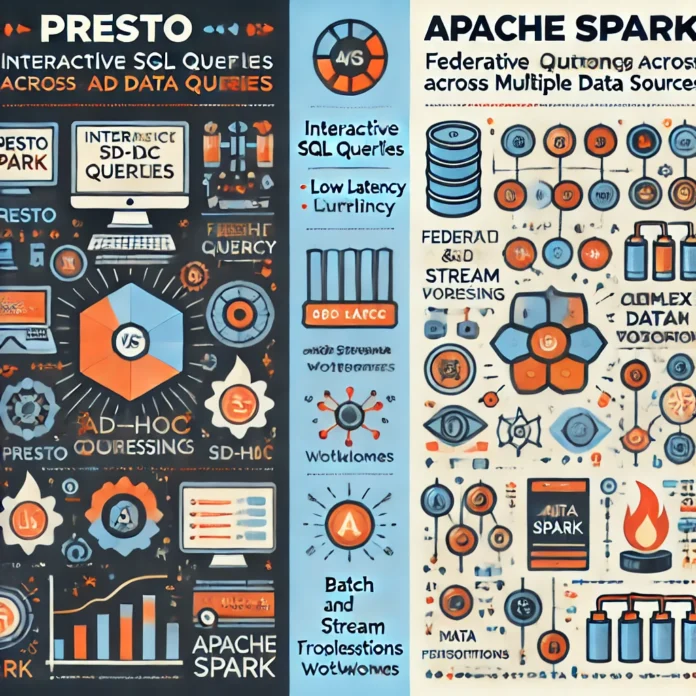In today’s data-driven world, handling massive amounts of data for analysis, reporting, and ad-hoc queries is crucial. Presto and Apache Spark are two popular distributed data processing engines designed to handle large-scale data processing. While both serve similar purposes, they have unique strengths, making them suitable for different scenarios.
This article explores how Presto and Spark can be used for ad-hoc queries, highlighting key features, examples, and use cases.
1. Presto: Interactive SQL Query Engine
Presto is an open-source distributed SQL query engine designed for running fast, interactive queries over large datasets. Originally developed by Facebook, it has since gained widespread adoption in companies like Airbnb, Netflix, and LinkedIn.
Key Features of Presto:
- SQL Interface: Presto supports ANSI SQL, making it easy for users familiar with SQL to run queries.
- Connectors for Multiple Data Sources: Presto can query data from various sources, including HDFS, S3, MySQL, and Kafka, among others.
- In-Memory Processing: Presto processes data in-memory, allowing it to return results quickly.
- Predicate Pushdown: Presto pushes down predicates (filters) to the underlying data source, reducing the amount of data processed.
Example of Using Presto for Ad-Hoc Queries:
Imagine you have a large dataset stored in Amazon S3 (in Parquet format), and you need to run some ad-hoc queries to analyze user behavior on your website.
Querying a Dataset Stored in S3:
- SELECT user_id, COUNT(*) AS total_actions
- FROM s3.web_actions
- WHERE event_type = ‘click’
- GROUP BY user_id
- ORDER BY total_actions DESC
- LIMIT 10;
This query calculates the top 10 users based on the number of clicks they made. The dataset is stored in S3, but Presto directly queries it without moving data, thanks to its integration with S3 and support for Parquet.
Joining Data from Multiple Sources:
Suppose you have user data in a MySQL database and website event logs in S3. Presto can join these datasets in a single query:
- SELECT u.user_name, COUNT(e.event_id) AS event_count
- FROM mysql.users u
- JOIN s3.web_actions e ON u.user_id = e.user_id
- WHERE e.event_type = ‘click’
- GROUP BY u.user_name
- ORDER BY event_count DESC;
In this query, Presto joins data from two different sources—MySQL and S3—and processes them together, providing a unified view.
Use Cases for Presto:
- Ad-Hoc Analytics: Presto excels in scenarios where analysts need to run interactive queries on large datasets. For example, an analyst may want to explore user behavior across different datasets stored in a data lake.
- Data Exploration: Data scientists and analysts can use Presto to quickly explore data, run complex joins, and filter large datasets without writing complex code.
- Data Federation: Presto is well-suited for querying across multiple data sources, including relational databases, NoSQL systems, and cloud storage, making it ideal for data federation.
2. Apache Spark: Distributed Processing Framework
Apache Spark is a powerful open-source distributed processing system designed for large-scale data processing. Spark supports a wide range of workloads, including batch processing, stream processing, machine learning, and graph processing. While Spark can also be used for querying data with SQL, it is more versatile than Presto due to its broader range of supported workloads.
Key Features of Apache Spark:
- Unified Analytics Engine: Spark can handle various types of data processing, from batch processing to real-time stream processing and machine learning.
- In-Memory Computing: Spark performs computations in-memory, which makes it extremely fast for iterative tasks, such as those found in machine learning algorithms.
- Spark SQL: Spark offers a SQL interface (Spark SQL) that allows users to run SQL queries on structured and semi-structured data.
- Wide Ecosystem: Spark integrates with various storage systems like HDFS, S3, Cassandra, and more.
Example of Using Spark for Ad-Hoc Queries:
Suppose you need to run ad-hoc queries on a large dataset of web logs stored in HDFS.
1-Using Spark SQL for Ad-Hoc Queries:
- from pyspark.sql import SparkSession
- #Create Spark session
- spark = SparkSession.builder.appName(“AdHocQueries”).getOrCreate()
- #Load data from HDFS
- logs_df = spark.read.parquet(“hdfs://path/to/web_logs”)
- #Register the DataFrame as a SQL temporary view
- logs_df.createOrReplaceTempView(“web_logs”)
- #Run an SQL query
- result_df = spark.sql(“””
- SELECT user_id, COUNT(*) AS total_events
- FROM web_logs
- WHERE event_type = ‘click’
- GROUP BY user_id
- ORDER BY total_events DESC
- LIMIT 10
- “””)
- #Show results
- result_df.show()
In this example, Spark SQL is used to query a large dataset of web logs stored in HDFS. The query calculates the top 10 users based on the number of clicks they generated.
2- Ad-Hoc Data Processing with Spark:
Spark is not limited to SQL. You can use it for more complex data transformations and analytics. For instance, if you need to pre-process the data before running an ad-hoc analysis, you can do so using Spark’s DataFrame API:
- Spark is not limited to SQL. You can use it for more complex data transformations and analytics. For instance, if you need to preprocess the data before running an ad-hoc analysis, you can do so using Spark’s DataFrame API:pythonCopy code
# Filter and preprocess data filtered_df = logs_df.filter(logs_df.event_type == "click").groupBy("user_id").count() # Show the results filtered_df.show() - #Filter and preprocess data
- filtered_df = logs_df.filter(logs_df.event_type == “click”).groupBy(“user_id”).count()
- #Show the results
- filtered_df.show()
Here, we filter the logs for “click” events and group by user_id to count the total number of clicks per user.
Use Cases for Apache Spark:
- Complex Data Transformations: Spark is ideal for scenarios where data needs to be preprocessed or transformed before analysis. This includes ETL (Extract, Transform, Load) pipelines and data enrichment processes.
- Machine Learning: Spark’s MLlib library provides a rich set of machine learning algorithms that can be applied to large datasets.
- Batch and Stream Processing: Spark can handle both batch and stream processing, making it suitable for real-time data processing use cases.
- Ad-Hoc Queries on Large Datasets: While not as optimized for interactive querying as Presto, Spark SQL can still be used for ad-hoc queries on very large datasets.
Presto vs. Apache Spark: Which One to Use?
While both Presto and Apache Spark can be used for querying large datasets, the choice of engine depends on the specific use case.
- Presto is best suited for interactive, low-latency queries where speed is crucial, such as running ad-hoc queries and exploring data in near real-time. Its ability to connect to multiple data sources simultaneously makes it ideal for federated queries and BI tools.
- Apache Spark, on the other hand, is a general-purpose engine that supports not only SQL queries but also complex data transformations, machine learning, and streaming. It’s the go-to choice when you need a versatile tool that can handle different types of workloads, including ETL pipelines, real-time analytics, and large-scale batch processing.
Key Differences:
- Latency: Presto generally provides lower latency for SQL queries compared to Spark. This makes it more suitable for interactive analytics.
- Workloads: Spark supports a broader range of workloads beyond just querying, including machine learning, graph processing, and streaming.
- Integration with Ecosystems: Presto is favored in environments with diverse data sources due to its connector-based architecture. Spark is often used in big data ecosystems, especially for tasks that require data processing beyond SQL.
Conclusion
Both Presto and Apache Spark are powerful tools for accessing and processing large datasets, but their strengths lie in different areas. If your primary need is running interactive SQL queries across multiple data sources with low latency, Presto is an excellent choice. For more complex data processing workflows, including ETL, machine learning, and real-time processing, Apache Spark is the preferred engine.
Choosing between Presto and Spark ultimately depends on the specific requirements of your use case, such as the type of data processing, the need for real-time analytics, or the complexity of the transformations involved.
By leveraging the strengths of both Presto and Spark, you can create a robust data processing pipeline capable of handling a wide variety of workloads, from simple ad-hoc queries to complex analytical tasks.




